
Reproduced from Vari, Ferraris and de Pinna (2005).
Denticetopsis praecox (Ferraris & Brown, 1991)
Identification: Denticetopsis praecox is distinguished from D. royeroi and D. sauli by the combination of the lack of elongate symphyseal teeth on the dentary, the lateral line extending posteriorly on the body beyond the abdomen onto at least the caudal peduncle, the presence of dentition on the vomer, a dorsal fin with 5 or 6 segmented rays and with the first ray that is spinous basally, a symmetrical, shallowly-forked caudal fin, and the possession of horizontally-elongate, stellate, dark chromatophores when the chromatophores are expanded. Denticetopsis praecox differs from D. epa in the relative length of the pelvic fin (tip of fin falling just short of the anterior margin of the vent versus reaching to the posterior margin of the vent, respectively) and in the number of premaxillary tooth rows (two rows of teeth versus three rows of teeth on premaxilla in all but the smallest examined specimens, respectively). Denticetopsis praecox differs from D. iwokrama in the number of preanal (14 to 15 versus 17, respectively), caudal (27 to 30 versus 32, respectively), and total vertebrae (38 to 40 versus 43, respectively), and in the pigmentation of the caudal-fin (a distinct, pale region present on distal portions of the middle fin rays versus a distinct, pale region in the distal portions of the middle fin rays absent, respectively). Denticetopsis praecox differs from D. macilenta in the relative position of the eye (located at anterior 0.25 of HL versus at anterior 0.18-0.19 of HL, respectively), the number of irregular rows of teeth on the median portions of the premaxilla (two versus three, respectively), in the profile of the postorbital portion of the head in dorsal view (convex versus approximately straight, respectively), and in the width of the head as a proportion of the length of the head (head width/HL 0.71-0.74 versus 0.77-0.84, respectively). Denticetopsis praecox differs from D. seducta in the pigmentation on the caudal fin (the presence of a distinct, pale region in the distal portions of the middle fin rays present versus the absence of a distinct, pale region in the distal portions of middle fin rays, respectively) and in the number of premaxillary tooth rows (two rows of teeth versus typically three rows in all but smallest examined specimens, respectively). Maximum size: 48 mm SL.
Range: Denticetopsis praecox is known from the Rio Baria of the upper Rio Negro basin in southern Venezuela.
Information from Vari, R. P., C. J. Ferraris Jr. & M. C. C. de Pinna. 2005. The Neotropical whale catfishes (Siluriformes: Cetopsidae: Cetopsinae), a revisionary study. Neotropical Ichthyology 3:127-238.
